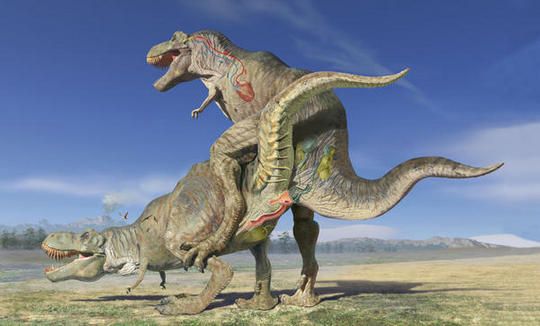Among the many issues with the fossil record is the case of gender identification. In modern organisms, it is usually pretty easy to tell which members of a particular species are the males and which are the females. This can either be through consistently perving on them to figure it out during copulation, or some aspect of their morphology, such as antlers, or you know, a penis or vagina. When it comes to fossil though, we often don’t find these typical gender-distinctive aspects of morphology preserved, as they are usually lost in one form or another to the ravages of time and the process of fossilisation.
DINOSAUR! But what does it mean..?
Palaeontology probably isn’t the most difficult of sciences, but it does incorporate aspects of chemistry, biology, and physics to a certain degree, as with many other geoscientific disciplines. Palaeontologists are also well known for the mysterious and unintelligible ‘science-speak’ that they use in research papers, fueled by this combination of a multitude of various sciences, the insane taxonomic system that we employ to identify fossils, and the standard anatomical descriptive phrasing too. I guess the aim of this series of posts, is just to break down some of the more complex terminology that you may come across online or in papers, and gain a bit more of an understanding of Palaeontology and related fields in the process. Yeah, it’s pretty much a glossary. With dinosaurs. Suggestions for words welcomed!
Which direction to take!?
One of the most important things palaeontologists and taxonomists do is the description of new species or fossils. Focussing on dinosaurs, because they’re the ones I know the best, there is a whole host of descriptive anatomy to get your head around. It’s not just the names of the bones; it’s also the names of the parts and structures within bones, including muscle scars and hypothesised muscles that attached to them. As well as this, you have to describe the relative position and spatial relationships between these elements to build a 3-dimensional image of a fossil based on descriptive terminology. This final part comes with a host of orientation related terminology, and can be incredibly confusing to decipher. At request from Sam Barnett (@Palaeosam), here’s an attempt to break it down, so that whenever you’re reading a description of a new species, you’ll hopefully be able to figure out some of the position-related jargon scientists have used!
Note, that while these can refer also to specific parts of the body, they can be used as relative terms too (e.g., the scutes are positioned dorsally, and the scutes are dorsal to the vertebral column).
Did dinosaurs lactate..?
The fossil record is brutally frustrating; it mostly preserves only vestiges of deaths long past as body fossils, with occasional glimpses of life being gleaned from their surroundings and any trace fossils, or activity fossils that we might find. One question palaeontologists have long been seeking the answer for is how good were dinosaurs as parents? Modern birds are descended from dinosaurs, and are pretty awesome parents in their nesting, brooding, and raising of their chicks from birth until they can quite literally fly the nest. But birds are the only extant group of dinosaurs out of three major lineages.

Partial skeleton of an oviraptorid dinosaur brooding over a nest of eggs. Source.

